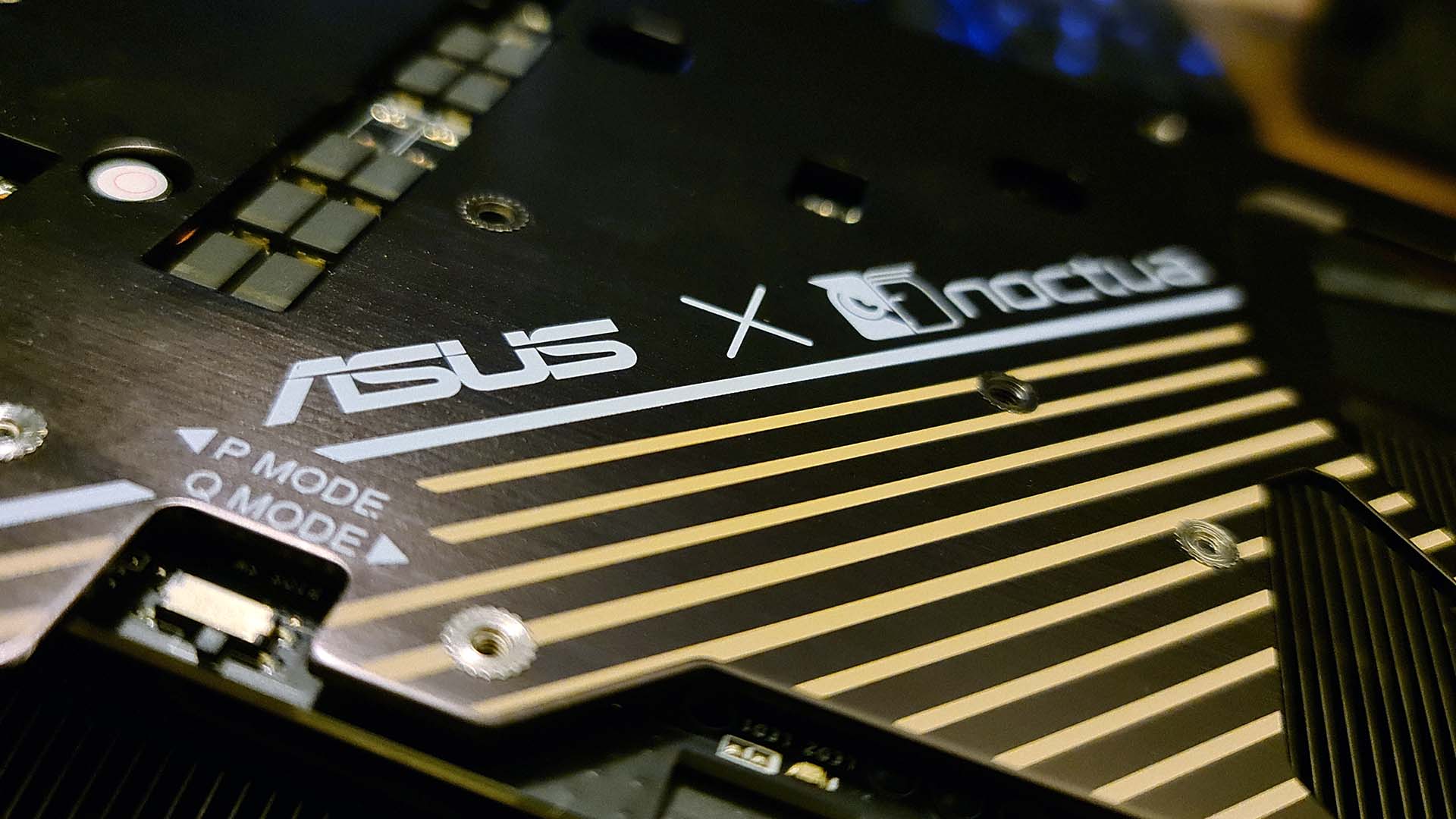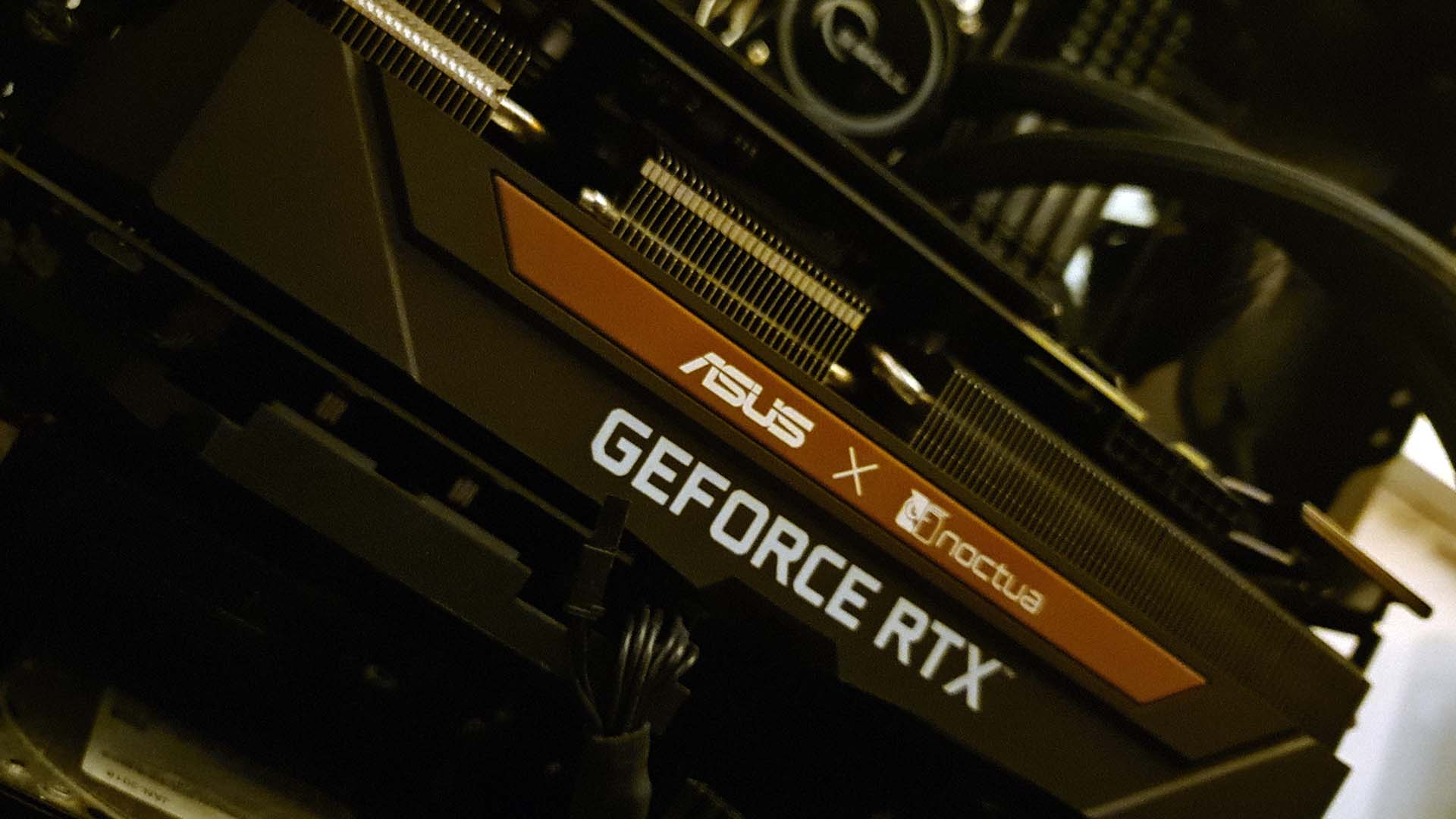I had to rebuild my PC for Asus & Noctua's beautifully brown RTX 3070 and I love it for that
This graphics card takes no prisoners: it's huge, cool, quiet, and oh so brown.

It's no secret that I'm a fan of the Asus GeForce RTX 3070 Noctua OC Edition. It's a graphics card that knows no limits, that breaks through societal beliefs of what colour a GPU should be, and has absolutely no regard for space-saving. It's somehow bigger than you expect, and that right there is why it's exactly the Noctua co-developed GPU I've been waiting for. And also why it's a huge nuisance to fit inside your PC case.

GPU: RTX 3070 (GA104)
CUDA Cores: 5,888
Tensor Cores: 184
RT Cores: 46
Boost clock: 1,845 MHz (OC Mode)
VRAM: 8 GB GDDR6
Memory speed: 14 Gbps
Memory interface: 256-bit
I/O: HDMI 2.1 x2, DisplayPort 1.4a x3
PSU requirement: 750W
Dimensions: 310 x 147 x 87.5 mm
Slot: 4.3
Price: $830 / £750
Yes, throwing aside any concept of a decent fan configuration and making a mess of my CPU's liquid cooling is the price I've had to pay to install the Asus GeForce RTX 3070 Noctua OC Edition inside my gaming PC. What was once a half-decent cooling setup within my slightly ageing Corsair Air 540 case has turned into a loosely placed mess of fans splayed out across the top of hard drives with minimal to no airflow. The triple-fan all-in-one that once kept my Ryzen 7 5800X cool now has just one fan attached, though I dare say it's all worth it.
That's partly because the rest of my components seem to be sufficiently cooled regardless of my now godforsaken setup, but mostly due to the Asus GeForce RTX 3070 Noctua OC Edition's extreme capability to maintain optimal thermal and acoustic performance seemingly regardless of external temperatures and cooling solutions.
So let's break down what makes this graphics card tick. At its core is Nvidia's GA104 GPU, which comes equipped with 5,888 CUDA Cores, 184 Tensor Cores, and 46 RT Cores. That's paired with 8GB of GDDR6 memory running at 14Gbps.
So far, so similar to Nvidia's own Founders Edition GeForce RTX 3070.
However, the Asus Noctua OC Edition is clocked higher than its reference compadre. The Founders Edition officially boosts to 1,725MHz, while the Asus Noctua OC Edition can be set up one of three ways: Silent Mode, which boosts up to 1,785MHz; Gaming Mode, which boosts up to 1,815MHz; and OC Mode, which boosts up to 1,845MHz. These three modes are enabled from within the Asus GPU Tweak II app, but you can also manually switch between both Silent and Gaming on the graphics card itself.
You'll notice the Silent Mode is actually higher than the Founders Editions' boost clock, which is a pretty impressive feat in itself.
Keep up to date with the most important stories and the best deals, as picked by the PC Gamer team.
| Header Cell - Column 0 | Boost clock (MHz) | Power target (%) | Temperature target (°C) |
|---|---|---|---|
| Silent Mode | 1,785 | 92 | 83 |
| Gaming Mode | 1,815 | 100 | 83 |
| OC Mode | 1,845 | 108 | 83 |
Nvidia's graphics cards will boost much further than what's on the box, however. That means both the Asus Noctua OC Edition and Founders Edition will reach far beyond what's on the tin. How far is down to headroom, both power and thermal, which means the Asus Noctua OC Edition should have the edge to push itself further than Nvidia's more modest model.
When comparing cooling solutions between these two RTX 3070 cards it's clear we're looking at an entirely different beast with the Asus Noctua OC Edition. The Noctua model is effectively constructed around twin NF-A12x25 120mm fans, which are much larger than the twin fans on the Founders Edition. While 120mm may be considered some of the smallest case fans around, I can attest to how absolutely massive they appear once attached to a graphics card.
These fans are mounted on top of a large, finely-tuned heatsink, which is 42.9 mm in height alone. Once combined with the shroud, PCB, and thermally considered backplate, this card hulks out to a considerable 310 x 147 x 87.5 mm. It's a 4.3-slot card, which really is extreme by any comparison.
This combination of large fans and heatsink makes for a graphics card that is both thermally sound and low noise, even inside a case that's, let's be honest, isn't the ideal setup for a GPU of this size. The larger fans needn't work as hard as, say, a triple-fan shroud, and that means they can spin at a lower RPM while maintaining plentiful airflow around the GPU's components.
While testing the card out in three games—Deathloop, Forza Horizon 5, and Metro: Exodus—I saw temperatures above 60°C only rarely in the balanced Gaming Mode. You can expect a small creep upwards when it comes to OC Mode, though there's hardly much in it.

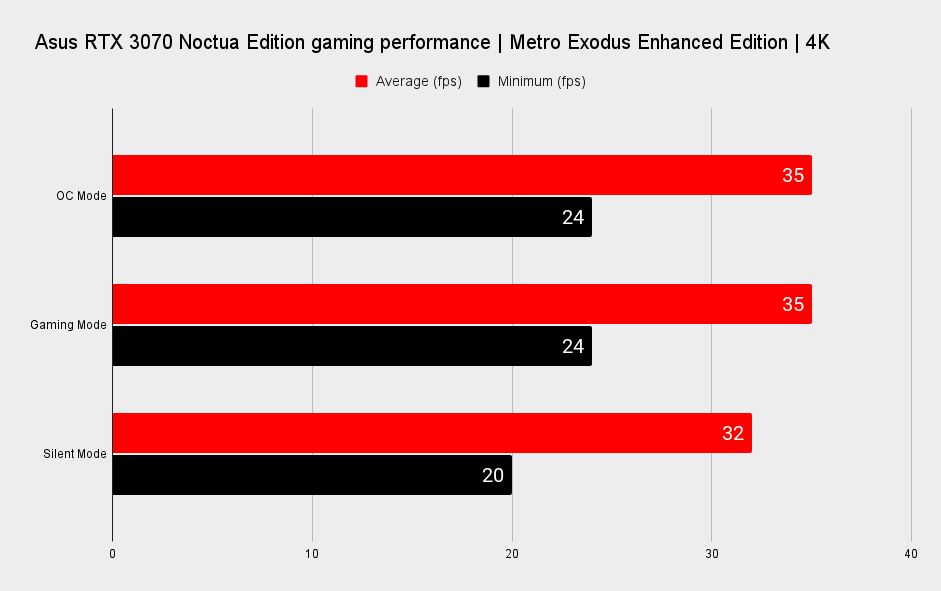
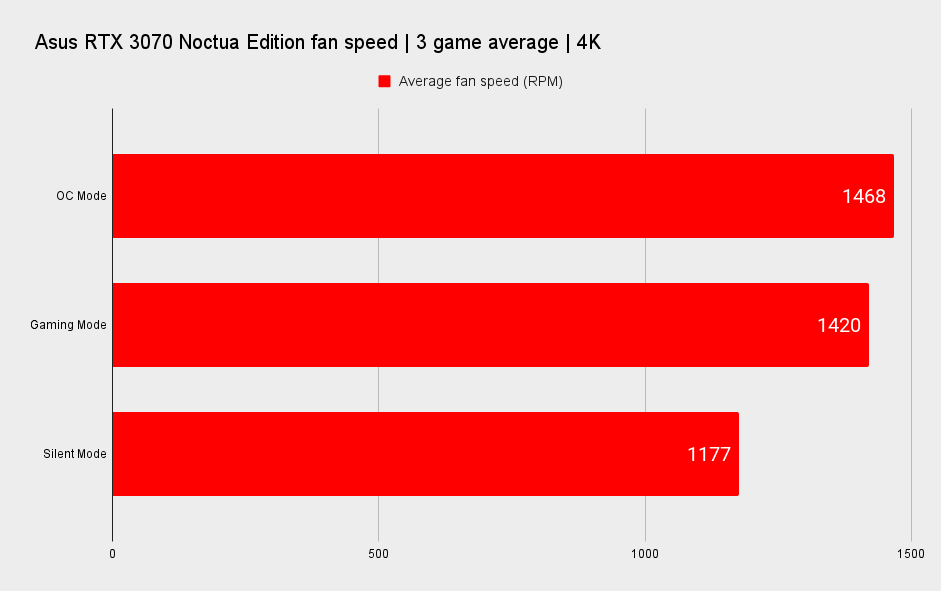
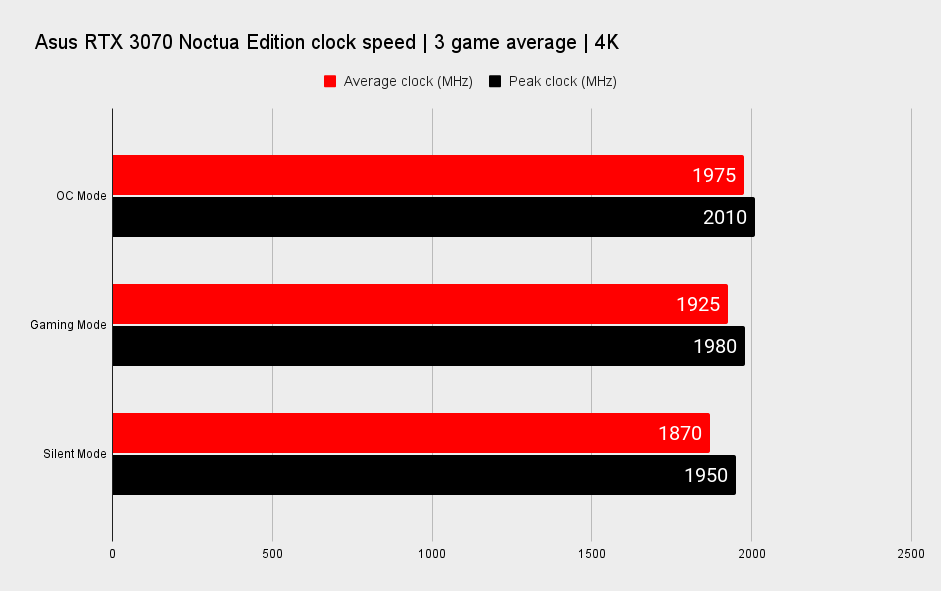
You net 30MHz or more for the step up to the OC Mode from the more balanced Gaming Mode, which is a small gain for an out-of-the-box tweak. Fan speeds do increase a touch to account for the extra juice the OC Mode demands, though not enough to make it that much louder. At least not be any noticeable margin while gaming, anyways. Though actual frames per second in Metro: Exodus Enhanced Edition didn't increase in my testing between OC and Gaming modes, so take it or leave it.
Both OC and Gaming modes also top out at an average clock speed faster than the Founders Edition RTX 3070, so you're getting something out of that overclock and cooler even once Nvidia's boost algorithm kicks in.
The other mode to consider is Silent Mode. This does make a significant difference to how the Asus Noctua OC Edition acts under pressure. Average clock speeds drop with the lower set boost clock and lower power budget, and as a result, the fan RPM can also be reduced without having a tremendously adverse impact on thermals. It's clocked low enough that thermals generally drop a degree or two from the other modes. The card's performance does dip as a result, but we're talking a small drop for less noise in operation. A decent price to pay for a slight drop in performance? Perhaps.
Whichever mode you're in, the 0dB mode will kick in under 50°C. Thus keeping your system as quiet as it can be at idle.
If you're the sort of person who wants the Asus GeForce RTX 3070 Noctua OC Edition, it's probably for the purpose of minimising noise or matching an aesthetic. Both are plenty valid reasons, and I would be tempted myself to dig out my Noctua NH-D15 and fitting beige and brown cables simply to match the overall aesthetic if I didn't have to part ways with the card sooner than I'd like to.
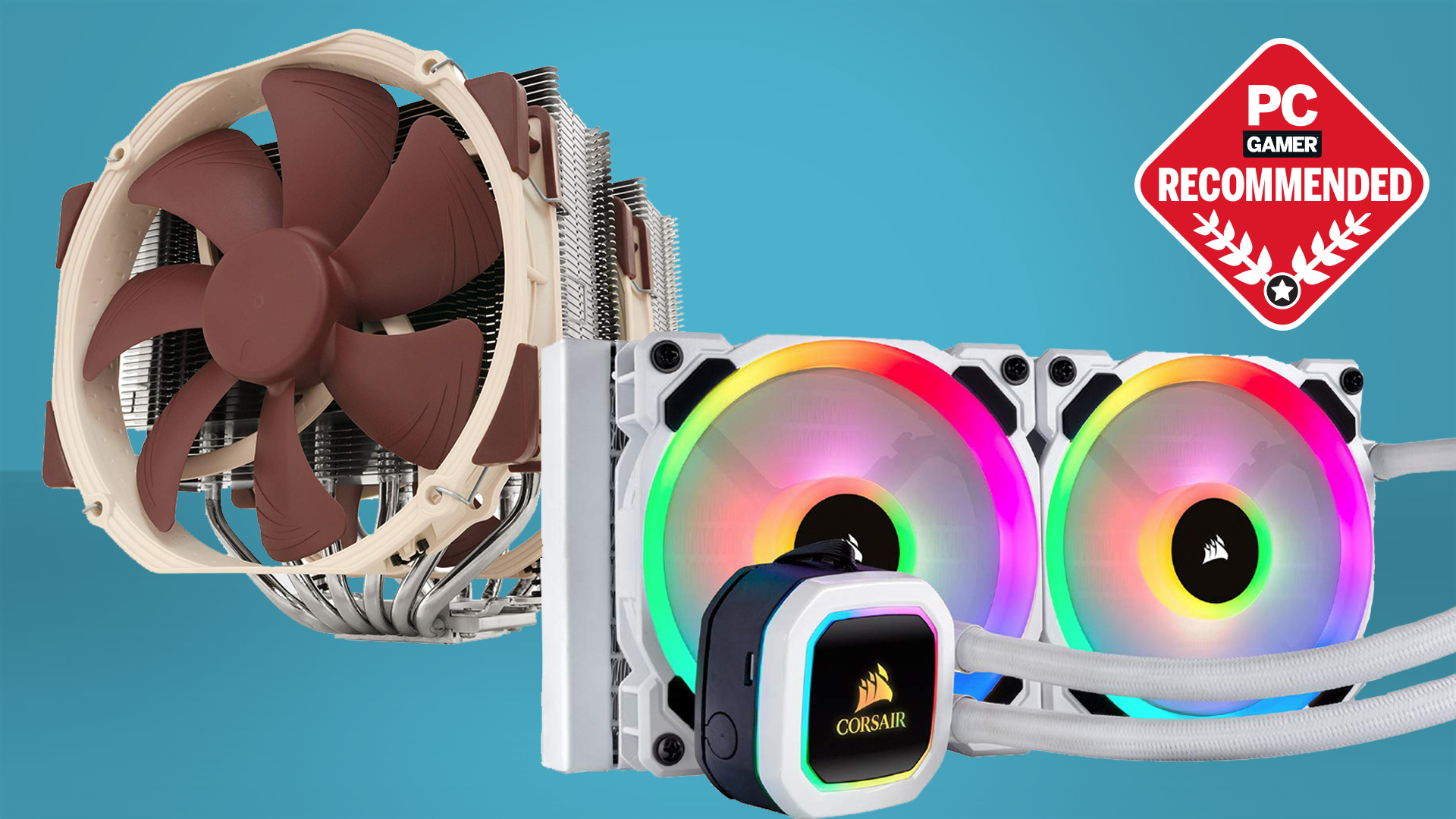
Best CPU cooler: keep your chip chilled in style
Best PC fans: super-silent and plastered in RGB
Best PC cases: big, little, and everything in-between.
Ideally, then, the perfect setup for a graphics card this quiet and cool in operation would be inside a case that can equally deliver adequate space for larger case fans to match. Some low-RPM 140mm case fans would work wonders to keep overall PC noise to a bare minimum, even during heavier workloads. Perhaps a BeQuiet! case with acoustic dampening would suffice enough to block out most of this card's noise. There's probably a pretty powerful yet completely silent PC you could build out of an AMD Ryzen CPU with a lowered TDP, Noctua's passive NH-P1, and this Asus Noctua OC Edition set to silent mode if you wanted to go the extra mile.
It's those sorts of silent-first builds that are going to make sense most for the arguably very pricey RTX 3070. The Asus Noctua OC Edition costs $830, but given the GPU shortage, it's very rarely found for a lot more or not at all. So I would expect that anyone truly interested in it has some sort of plan of attack to get the most out of it, otherwise you're better off buying a third-party card for cheaper or a higher-tier GPU for the same price (if you can find one, that is).
Personally, though, I'm smitten because this graphics card has delivered everything I'd hoped for from such a partnership. It felt only a matter of time before Noctua turned its expertise on the GPU market, and I'm glad that now it has, the end product is something audacious enough to be worthy of the reputation. And that I didn't mind tearing down my PC for.

Jacob earned his first byline writing for his own tech blog, before graduating into breaking things professionally at PCGamesN. Now he's managing editor of the hardware team at PC Gamer, and you'll usually find him testing the latest components or building a gaming PC.
